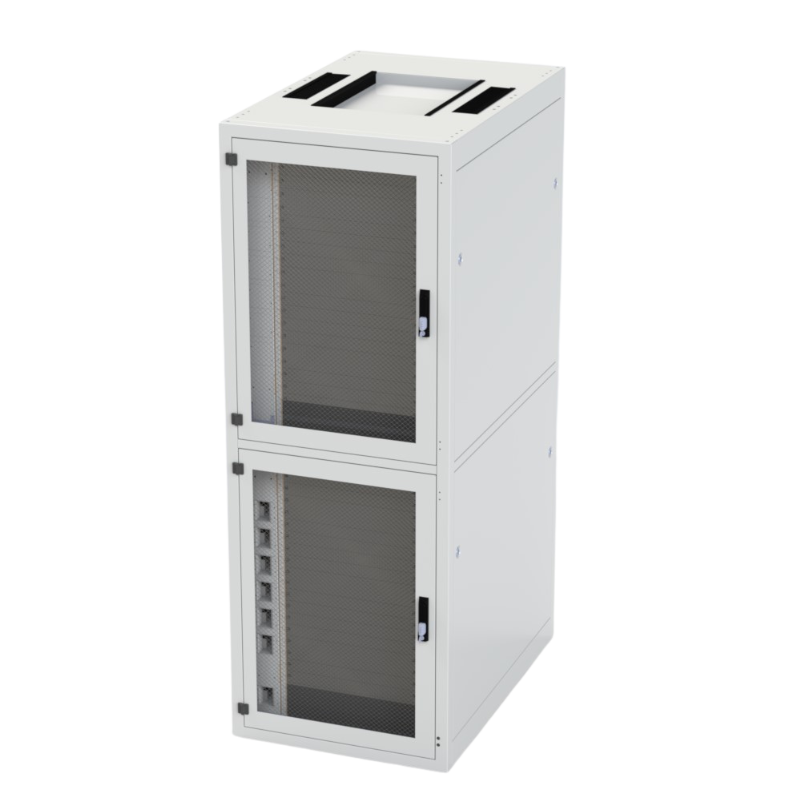The choice of server and network racks is pivotal in data centres because it impacts the efficiency, security, scalability, and maintenance of the IT infrastructure, as well as space efficiency. Data centre racks come in various sizes, each designed to accommodate different server sizes and configurations. Here’s some insight into the world of data centre racks, exploring sizing units, different rack sizes, and what to factor in when calculating the correct rack size for your specific needs.
Sizing units: rack units (U)
Data centre server racks are typically designated by height, measured in ‘rack units’ or ‘U’. One rack unit is equivalent to 1.75 inches (44.45 mm) in height. This unit of measurement serves as the basis for specifying both the height of the server rack and the height of the servers themselves.
The standard height for server racks goes up to 6-7 feet, with 42U and 48U being the most popular sizes, but they start from 21U. As data centres more densely populated with servers and other equipment, 52U is also growing in popularity, standing at 8 feet and Rainford has a high-density colocation and hyperscale 60U rack, providing 43 per cent more space than a standard 42U, but with the same footprint.
Server rack width
The depth of a rack determines how much equipment it can hold and how well it accommodates the specific server and networking gear you plan to install. The key is to have a rack deep enough to accommodate equipment effectively and that utilises valuable floor space efficiently. Rack depths can vary significantly, with some racks designed for shallow equipment and others for deep servers or networking switches. Typical depths range from 600mm to 1200mm (23 inches to 47 inches), with popular options being 24 inches and 48 inches.
As data centre designs become denser, deeper racks are becoming increasingly popular to accommodate deeper equipment.
Calculating the correct rack size
Selecting the right server rack size is crucial to ensure space efficiency, effective cooling and heat management, power distribution, cable management, maintenance and security. Here’s what to consider when calculating the correct rack size for your needs.
1. Inventory assessment
Start by taking an inventory of all the equipment you plan to install in the rack. List each piece of equipment, noting its height in rack units (U), depth, and width.
2. Futureproofing
Leave some room for future expansion and ease of maintenance. It’s recommended to allocate at least 20-30% more space than you currently need.
3. Considerations for rack height
When it comes to rack height, obviously it must accommodate your equipment, but will it fit through standard openings in building entrances and lifts and not interfere with overhead sprinkler systems?
4. Cooling and accessibility
Factor in cooling requirements. Ensure that there is sufficient space for airflow and that cooling systems can effectively dissipate heat. Additionally, consider the accessibility of equipment for maintenance and servicing.
Whether you are building a new data centre or upgrading an existing one, thoughtful consideration of rack sizes is a fundamental step toward a well-organised and high-performing infrastructure.
Why Rainford for Data Centre Racks?
Our range of server and network racks and cabinets will optimise data centre space, thermal management and power and network cable assemblies for your critical hardware.
Available in off-the-shelf modular format with an array of configurable options, or cost-effective designed customer specific solutions. ETSI format and compliant with EN 300 119.
Adaptability is designed in with flexible cable management options, multiple door options and heat management features. All are supplied from our UK manufacturing site, fully assembled for quick and easy deployment.
Get in touch for more information.




